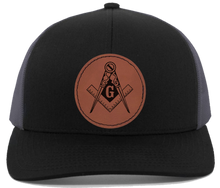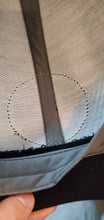Masonic square and compass engraved Leather Patch hat, Industrially sewn on by hand to ensure the highest quality!
Adjustable size- 6 3/8 (51cm) to 8 (64cm)
Custom logos or designs are always available under our design your own engraved products, Design your own leather patch hats online here, Patches are engraved and sewn on, and patch options will be round, oval, and rectangular.
"Get Inspired" with JTM VINTAGE  ®
®
History facts:
A few famous masons include George Washington, Benjamin Franklin, John Hancock, Paul Revere, Mozart, Lafayette, Andrew Jackson, Thurgood Marshall, Winston Churchill, Harry Houdini, Mark Twain, Oscar Wilde, Jesse Jackson, Duke Ellington, Gerald Ford, Buzz Aldrin, Nat King Cole, Douglas MacArthur, Clark Gable, Salvador Dali, Henry Ford, Charles Lindbergh, John Wayne, Irving Berlin, Simon Bolivar, Edward VIII, Benjamin Disraeli, Robert Burns, Rudyard Kipling, and Jules Verne
via Masonic Service Association of North America
No one knows with certainty how or when the Masonic Fraternity was formed. A widely accepted theory among Masonic scholars is that it arose from the stonemasons’ guilds during the Middle Ages. The language and symbols used in the fraternity’s rituals come from this era. The oldest document that makes reference to Masons is the Regius Poem, printed about 1390, which was a copy of an earlier work. In 1717, four lodges in London formed the first Grand Lodge of England, and records from that point on are more complete.
Within thirty years, the fraternity had spread throughout Europe and the American Colonies. Freemasonry became very popular in colonial America. George Washington was a Mason, Benjamin Franklin served as the head of the fraternity in Pennsylvania, as did Paul Revere and Joseph Warren in Massachusetts. Other well-known Masons involved with the founding of America included John Hancock, John Sullivan, Lafayette, Baron Fredrick von Stuben, Nathanael Greene, and John Paul Jones. Another Mason, Chief Justice John Marshall, shaped the Supreme Court into its present form.
Over the centuries, Freemasonry has developed into a worldwide fraternity emphasizing personal study, self-improvement, and social betterment via individual involvement and philanthropy. During the late 1700s it was one of the organizations most responsible for spreading the ideals of the Enlightenment: the dignity of man and the liberty of the individual, the right of all persons to worship as they choose, the formation of democratic governments, and the importance of public education. Masons supported the first public schools in both Europe and America.
During the 1800s and early 1900s, Freemasonry grew dramatically. At that time, the government had provided no social “safety net”. The Masonic tradition of founding orphanages, homes for widows, and homes for the aged provided the only security many people knew.
Today in North America, the Masonic Fraternity continues this tradition by giving almost $2 million each day to causes that range from operating children’s hospitals, providing treatment for childhood language disorders, treating eye diseases, funding medical research, contributing to local community service, and providing care to Masons and their families at Masonic Homes.
The four million Masons worldwide continue to help men and women face the problems of the 21st century by building bridges of brotherhood and instilling in the hearts of men ideals for a better tomorrow.
A Grand Lodge
The first Grand Lodge was founded only a few years after George I, the first Hanoverian king of the Kingdom of Great Britain, ascended to the throne in August 1714 and the end of the first Jacobite rising of 1715. Officially, the Grand Lodge was founded on 24 June 1717, St. John the Baptist’s day, when four existing Lodges gathered at the Goose and Gridiron alehouse in St Paul’s Churchyard, London and constituted themselves as a Grand Lodge. It is this date which is often cited as the ‘founding’ day of Freemasonry in its modern sense.
300 years ago the Premier Grand Lodge of England, the first Masonic Grand Lodge in the world (now the United Grand Lodge of England), was founded in London to govern Freemasonry.
What is Freemasonry?
Dogged by conspiracy theories, implicated in countless political intrigues and long seen as a secretive, shadowy international society dominated by ancient rituals, there are very few people who can accurately or confidently describe who the Freemasons are or what they do. Yet Freemasonry is ‘one of the world’s oldest and largest non-religious, non-political, fraternal and charitable organizations’, according to the United Grand Lodge of England, the governing body of Freemasonry in England, which teaches ‘self-knowledge through participation in a progression of ceremonies’ and is ‘a society of men concerned with moral and spiritual values’. Working to make ‘good men better’, Masons call each other brothers because they believe they are all equal. Through charitable work they climb up the hierarchy, wearing traditional regalia to indicate their rank within the organization. Generally, to be accepted for initiation as a regular Freemason a candidate must be male; aged over 21; come of his own free will; be of good morals, reputation and financial standing and believe in some kind of Supreme Being.
The basic, local organizational unit of Freemasonry is the Lodge, usually supervised and governed by a sovereign Grand Lodge, who meet regularly to conduct organizational business, elect new members, have dinners and perform ceremonies to confer Masonic degrees. The bulk of Masonic ritual consists of degree ceremonies, through which candidates are progressively initiated in to Freemasonry. There are three basic degree levels: Entered Apprentice, Fellow Craft and Master Mason.
A Grand Lodge
The first Grand Lodge was founded only a few years after George I, the first Hanoverian king of the Kingdom of Great Britain, ascended to the throne in August 1714 and the end of the first Jacobite rising of 1715. Officially, the Grand Lodge was founded on 24 June 1717, St. John the Baptist’s day, when four existing Lodges gathered at the Goose and Gridiron alehouse in St Paul’s churchyard, London and constituted themselves as a Grand Lodge. It is this date which is often cited as the ‘founding’ day of Freemasonry in its modern sense.
The four Lodges, which had existed for some time, had previously met together in 1716 at the Apple Tree Tavern and resolved to hold an annual assembly and feast and choose a Grand Master from amongst themselves. All four Lodges were simply named after the public houses in which they met: the Goose and Gridiron alehouse (now called Lodge of Antiquity No.2); the Crown alehouse in Parker’s Lane, off Drury Lane; the Apple Tree Tavern in Charles Street, Covent Garden (now called Lodge of Fortitude and Old Cumberland No.12); and the Rummer and Grapes tavern in Channel Row, Westminster (now called Royal Somerset House and Inverness Lodge No. IV). The new body became known as the Grand Lodge of London and Westminster, later calling itself the Grand Lodge of England (although convention calls it the Premier Grand Lodge of England to distinguish it from its rival the Ancient Grand Lodge of England). Anthony Sayer, believed to be the oldest of the existing Master Masons, was elected the first Grand Master, although little is known about him. The next, George Payne, was the last commoner to serve as Grand Master – he rose to a high position within the Commissioners of Taxes and served as Grand Master twice in 1718-19 and 1720-21. The year in between was taken by John Theophilus Desaguliers, an eminent scientist, clergyman, Fellow of the Royal Society and pupil of Sir Isaac Newton. Thereafter, in what might be regarded as a deliberate attempt to raise the profile of the organization, every Grand Master has been a member of the nobility.
The Constitutions of the Free-Masons
Since no records were taken until 1723, the early history of the Grand Lodge is uncertain. However, in 1720 Payne took it upon himself to write the General Regulations of a Free Mason, which were later incorporated into Revd. Dr. James Anderson’s The Constitutions of the Free-Masons, which was published in 1723 and contained the history, charges, and regulations of ‘that most ancient and right worshipful fraternity’ to be used in Lodges in London and Westminster. According to Anderson, he was commissioned to digest the old ‘Gothic Constitutions’ in palatable, modern form and, for the first time, all of freemasonry, except for the ritual, was available in a printed book. Anderson’s Constitutions claim that the history of Freemasonry is ancient, tracing the fraternity back to biblical roots. Whilst it is generally accepted that much of this is based on myth and legend and therefore unreliable, the work remains a milestone in masonic history and the claim that Freemasonry dates back to ancient times continues to be repeated to this day. So important was Anderson’s work, it was reprinted in 1734 by one of the Founding Fathers of the United States, Benjamin Franklin, who in that year was elected Grand Master of the Masons in Philadelphia.
By the time Anderson’s rule book was published in 1723, the Grand Lodge was meeting quarterly and had extended its authority outside London. By 1725 there were lodges at Bath, Bristol, Norwich, Chichester, Chester, Reading, Gosport, Camarthen, Salford, Warwick and embryonic Provincial Grand Lodges in Cheshire and South Wales. The first Grand Lodge of Ireland was also established that year.
History of Freemasonry
The history of Freemasonry is generally separated into two time periods: before and after the formation of the Grand Lodge of England in 1717. The facts and origins of Freemasonry before the Grand Lodge existed are not absolutely known and are still subject to intense speculation. Most Masonic scholars believe that it descends from the emergence of organised lodges of operative stone masons who built the cathedrals and castles of the Middle Ages, but in its ritual context Freemasonry employs an allegorical myth – that the fraternity was founded by the builders of King Solomon’s Temple in Jerusalem. Other popular theories as to the origins of Freemasonry include: it is a direct descendant of the Knights Templar; the construction of the Rosslyn Chapel in Scotland being the interface between the Knights Templar and Freemasonry; it was created by Francis Bacon, Oliver Cromwell or Stuart pretenders to the British Crown; it was a result of Sir Christopher Wren and the rebuilding of St. Paul’s Cathedral.
‘Antients’ and ‘Moderns’
Throughout the early years of the new Grand Lodge many Lodges never affiliated with it. These independent Masons and Lodges were referred to as ‘Old Masons’, ‘St. John Masons’ or St. John Lodges’. In 1725 a lodge in York founded the rival Grand Lodge of All England in protest against the growing influence of the Grand Lodge of England and in the 1730s and 1740s antipathy between the two Grand Lodges, and those of Scotland and Ireland, increased when some Masons considered the Grand Lodge of England to have deviated considerably from the ancient practices of the Craft.
Things rose to a head, when, in 1751, representatives from a group of mostly Irish unaffiliated Lodges met at the Turk’s Head Tavern in Greek Street, Soho – to form the Grand Committee of a new, rival Grand Lodge, which they call The Most Antient and Honourable Society of Free and Accepted Masons. This society – ‘The Antients’ – practiced a more ancient form of Masonry, which they considered to be purer and more authentic and grew rapidly under the influence of Laurence Dermott, who was Grand Secretary from 1752 to 1771 and Grand Master intermittently after. The Antients referred to those affiliated to the Grand Lodge of England using the derogatory epithet ‘The Moderns’.
Union
In the 1790s relations between these two major English Freemasonry bodies thawed, and on 27 December 1813 (the day of Saint John the Evangelist), after four years of negotiations, the Grand Lodge of England and Antient Grand Lodge of England came together to form the United Grand Lodge of England (UGLE) with the Duke of Sussex as Grand Master.
Freemasonry is fundamentally a self-improvement, volunteer association that teaches moral, intellectual, and spiritual lessons through three initiation ceremonies. Freemasonry’s three degree are modeled after a craftsman’s progress: Apprentice, Fellowcraft, and Master Mason. Freemasonry was, and remains, open to all men of good reputation who profess a belief in Deity (referred to in lodge as The Supreme Architect of the Universe). By the 1750s a variety of Christian and non-Christians, European, and non-European men, and a few women, were members.2
Freemasonry grew popular within cities as political, commercial, and intellectual elites gathered within a lodge. With aristocratic, and later royal patronage, Freemasonry evolved into the preeminent fraternal organization of the eighteenth century. The earliest records of American Masonic lodges are in Philadelphia. In 1732, Boston’s St. John’s Lodge was duly constituted by the Grand Lodge of England and remains the oldest lodge in North America. Interwoven with the British Enlightenment, Masonic lodges formed throughout Europe and the Americas. The network of Scots, English, and Irish Lodge helped knit the British commercial empire together.3
Although American elites initially joined the Freemasons to keep pace with genteel English behavior, the fraternity contributed to the spread of the ideas and ideals behind the American Revolution. During the revolutionary era, Masons of note included George Washington, Benjamin Franklin, James Otis, and Paul Revere. While individual Freemasons actively participated in the American Revolution, Freemasonry, as an institution as well as its local lodges, remained politically neutral.4
Washington joined Freemasonry in the Lodge at Fredericksburg, Virginia. He was 20 years old when he received the first degree of Entered Apprentice on November 4, 1752. He paid the lodge two pounds and three shillings to join. Ten days after turning 21, on March 3, 1753, he was passed to the second degree of Fellowcraft. On August 4, 1753, he was raised to the third degree of Master Mason. The lodge’s surviving minute book records Washington attending only two more meetings: September 1, 1753, and January 4, 1755.5
Many of Washington’s brothers in the Fredericksburg Lodge later served within in the Continental Army or Virginia Militia, including Hugh Mercer, George Weedon, and Thomas Posey. Washington’s “Mother Lodge” was renamed and numbered as Fredericksburg Lodge No. 4 after the creation of the Grand Lodge of Virginia in 1778. It continues to meet today.6
Beginning in 1778 and through the remainder of his life, Washington was a frequent participant in Masonic ceremonies. On June 24, 1779, for example, Washington attended American Union Lodge’s celebration of the Feast of St. John the Baptist. That lodge comprised officers and enlisted men within the Connecticut regiments. He also visited King Solomon’s Lodge in Poughkeepsie, New York, on December 27, 1783.7
After the war, in 1784, Washington accepted the invitation of his friends and neighbors to attend a June banquet at Alexandria Lodge No. 39, where he was elected an honorary member. Four years later he agreed to be charter master of the lodge when it transferred its allegiance from the Grand Lodge of Pennsylvania to the Grand Lodge of Virginia. In 1794, the lodge commissioned William Williams to paint Washington dressed in Masonic regalia. After Washington’s death the lodge changed its name to Alexandria-Washington Lodge No. 22.8
As president, Washington exchanged letters with many Masonic local lodges and state grand lodges. He also met delegations of Freemasons during his visit to Rhode Island in 1790 and his 1791 tour of the southern states. His most significant Masonic activity, however, occurred on September 18, 1793. Acting as grand master pro tem, he presided at the Masonic ceremonial laying of the United States Capitol cornerstone.9
At Washington’s 1799 funeral, brothers of Alexandria Lodge performed Masonic rites. After Martha Washington’s death the lodge acquired many valuable items from the estate, including a Masonic apron sent from France in 1793. With these items and many curiosities, the lodge opened a museum in 1812.10
In 1910 the George Washington Masonic National Memorial Association was formed. Then in 1932 the Association dedicated its great Masonic Memorial to Washington in Alexandria, Virginia. Today Alexandria-Washington Lodge No. 22 displays many of its valuable Washington artifacts and continues to meet there. The George Washington Masonic National Memorial welcomes the public seven days a week to view its many exhibitions and enjoy the spectacular view for the top of its 333 foot tower.11
Washington himself best articulated his membership in, and relationship to, Freemasonry when he replied to the brethren of King David’s Lodge in Newport, Rhode Island, in 1790:
Being persuaded that a just application of the principles, on which the Masonic Fraternity is founded, must be promotive of private virtue and public prosperity, I shall always be happy to advance the interests of the Society, and to be considered by them as a deserving brother. 12
Mark A. Tabbert
Director of Collections
George Washington Masonic National Memorial Association







